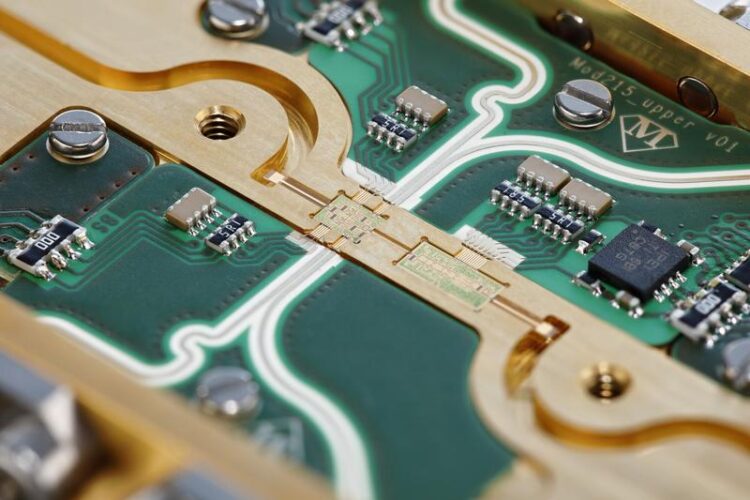Fraunhofer IAF presents outstanding results of MMIC research and development

mHEMT-based E-band transmitter module for high-bit-rate satellite communication.
(c) Fraunhofer IAF
Fraunhofer IAF shows its latest advances in high-frequency electronics based on III-V compound semiconductors at the European Microwave Week 2023 (EuMW) in Berlin. In addition to its participation at the trade fair, the institute is represented in 18 conference papers and its researcher will give presentations, among others, on integrated circuits for terahertz frequencies as well as submillimeter-wave MMICs and modules.
From satellite communications to directional radio links for Industry 4.0 and 5G/6G as well as cryogenic electronics for quantum computing and radio astronomy: The Fraunhofer Institute for Applied Solid State Physics IAF will present its latest advances in high-frequency electronics at this year’s EuMW in Berlin. In 2023, the Freiburg institute is particularly well represented at Europe’s leading trade fair for radar, microwave and high-frequency technology: In addition to the exhibition booth, Fraunhofer IAF researchers are participating in 18 conference presentations, eleven of them as main speakers.
Moise Safari Mugisho from Fraunhofer IAF, for example, will present his latest advances in millimeter-wave monolithic microwave integrated circuits (MMICs) and modules at EuMW. Among them are remarkable results such as the 42 % power added efficiency (PAE) of a 24 GHz harmonic injection Doherty power amplifier.
Felix Heinz gives a talk on a cryogenic small-signal and noise model for 50 nm metamorphic high-electron-mobility transistors (mHEMTs), which is capable of precisely describing the radio frequency (RF) properties of such transistors when operated with lowest DC power consumption at cryogenic temperatures. The model predicts the electrical behavior at drain currents and drain voltages as low as 1 mA/mm and 0.05 V, respectively. The presented model is widely scalable in terms of gate width and number of gate finger, which covers at least the absolute gate width range from 10–480 µm. To the best of the authors’ knowledge, this is the first demonstration of a scalable cryogenic small-signal and noise model that is able to describe transistors down to DC powers as low as at least 0.05 mW/mm.
Furthermore, Philipp Neininger will present an ultra-wideband digital step attenuator (DSA) for the frequency bands between 40 and 220 GHz, based on the 35 nm mHEMT technology of Fraunhofer IAF. A paper by Laurenz John describes the results of the low-noise amplifier (LNA) development for the Arctic Weather Satellite (AWS) of the European Space Agency (ESA). Three LNA circuits, covering the frequency bands around 54 GHz, 89 GHz as well as 165 to 183 GHz, have been fabricated in a 50 nm InGaAs channel mHEMT technology, packaged into waveguide modules, and qualified for the AWS proto-flight model.
Peak results in efficiency will be shown in Bharath Kumar Cimbili’s paper on current state-of-the-art E-band GaN power amplifiers. The power amplifiers demonstrated in this work exceed previous power amplifier III-V technologies in terms of efficiency and power gain. The design of a V-band power amplifier using the 150 nm GaN technology of Fraunhofer IAF demonstrates an unprecedented power density of 2.5W/mm at a bandwidth exceeding 10 GHz.
“With the outstanding results we show at this important conference, we confirm our leading position in the field of III-V semiconductor MMIC research and development”, says Dr. Matthias Ohlrogge, Division Manager Business Units at Fraunhofer IAF. “Also, the fact that our partners from industry and academia present new findings and developments based on our technology at EuMW 2023 shows our capabilities.”
An overview of the papers of Fraunhofer IAF is available for download (PDF).
Latest developments at the booth
The EuMW exhibition from September 19 to 21, 2023, in Berlin brings together industry and academia from around the world and provides access to the latest products, research and initiatives in the microwave sector. Fraunhofer IAF will present its research and development activities together with TNO and Fraunhofer FHR at a joint booth (Hall 1, Booth 104B).
Visitors are invited to make an appointment for a personal meeting with the researchers at the booth via electronics@iaf.fraunhofer.de.
Student Career Event
Fraunhofer IAF also participates in a special event for students: Together with nine other leading companies in the field of high-frequency electronics, the institute will introduce itself to young scientists during an exclusive evening event with a presentation and speed dating. The Student Career Event will take place on Wednesday, September 20, 2023, starting at 8 p.m.
Further information
Overview of the papers of Fraunhofer IAF for download (PDF): https://www.iaf.fraunhofer.de/content/dam/iaf/documents/veranstaltungen/Fraunhof…
Press contact:
Stefanie Griesser
Marketing and Communications
stefanie.griesser@iaf.fraunhofer.de
Information about and registration for EuMW 2023: https://www.eumweek.com/
Weitere Informationen:
Media Contact
All latest news from the category: Event News
Newest articles

Sea slugs inspire highly stretchable biomedical sensor
USC Viterbi School of Engineering researcher Hangbo Zhao presents findings on highly stretchable and customizable microneedles for application in fields including neuroscience, tissue engineering, and wearable bioelectronics. The revolution in…

Twisting and binding matter waves with photons in a cavity
Precisely measuring the energy states of individual atoms has been a historical challenge for physicists due to atomic recoil. When an atom interacts with a photon, the atom “recoils” in…

Nanotubes, nanoparticles, and antibodies detect tiny amounts of fentanyl
New sensor is six orders of magnitude more sensitive than the next best thing. A research team at Pitt led by Alexander Star, a chemistry professor in the Kenneth P. Dietrich…





















